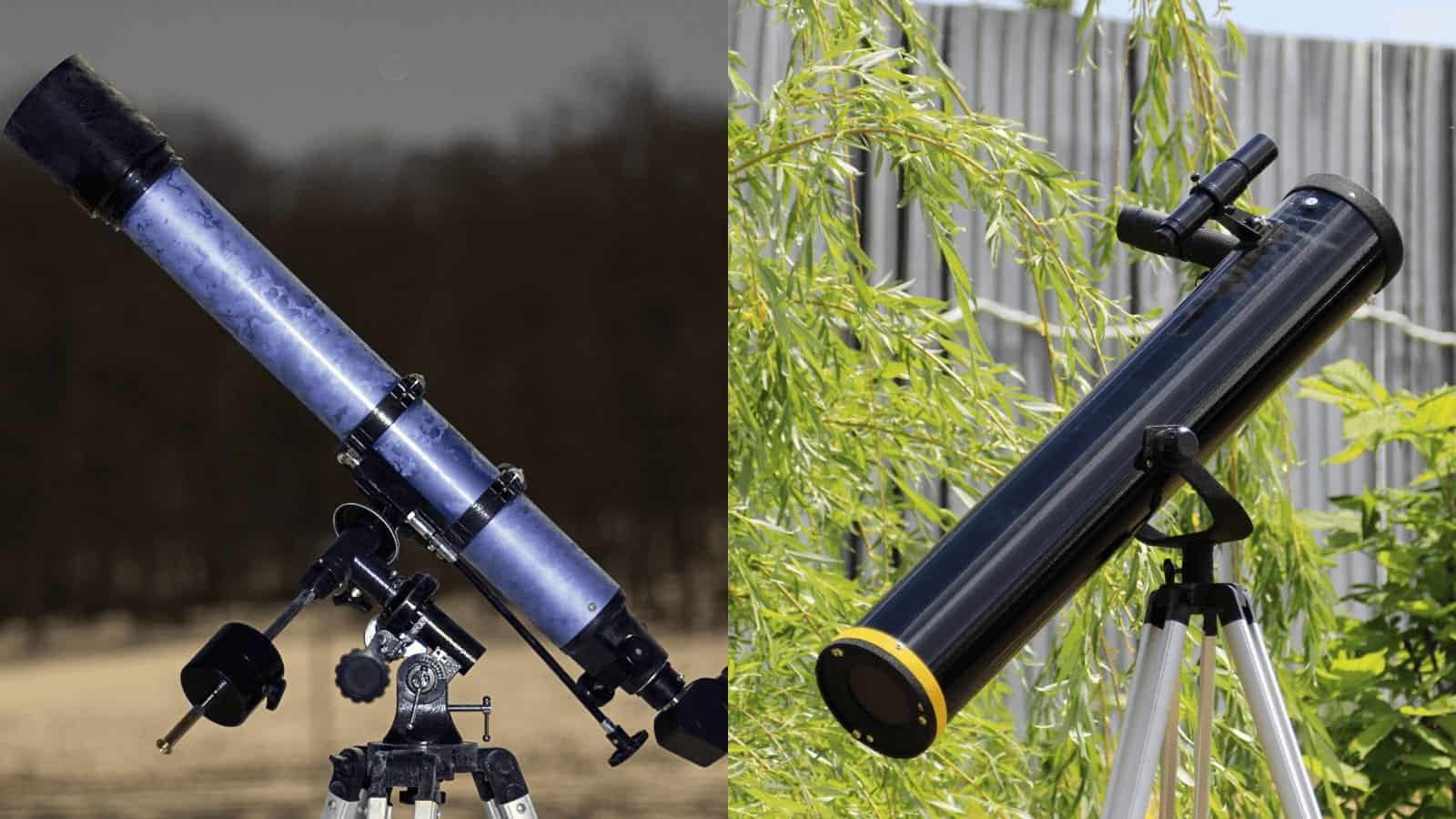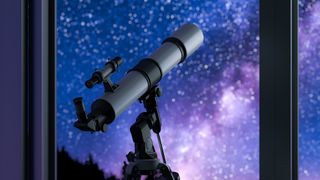Do Telescopes Work by Using Optics Which Means Light
The aperture gathers light and the larger your aperture the more light that your telescope can collect and bring into focus. Just like telescopes eyepieces come in.

Monocular Telescopes For Iphone Smartphone Adults Kids 10x42 High Power Hd Watching Fish Travelling Smartphone Holder Monocular Camera Phone
A scope works just like a telescope by collecting light from the object and creating a focused image where the crosshairs create a specific point at which to aim.

. Except for the gamma-ray and x-ray telescopes the telescopes use the same old parabolic mirror design to gather light. 11 Light-Gathering and Image Formation Optical telescopes make use of 2 phenomena. D It allows ground-based telescopes to observe ultraviolet light that normally does not penetrate the atmosphere.
Convex lenses work by bending light inwards like in the diagram. May 27 2017 at 300. The sun istoo bright.
Reflection of light by mirrors Figure 1 and Refraction of light by lenses Figure 2 Figure 1. No its huge problem. Well typically binoculars are 2 telescopes Trusted Source Telescope - Wikipedia A telescope is an optical instrument using lenses curved mirrors or a combination of both to observe distant objects or various devices used to observe distant objects by their emission absorption or reflection of electromagnetic radiation.
A two-element telescope composed of a mirror as the objective and a lens for the eyepiece is shown. Composite lenses correct for chromatic. Then we will talk about some nuances involved in drawing ray diagrams and derive an expression for magnifying power.
A telescopes job is to gather and concentrate the light emitted by celestial objects into a point. For all telescopes it is the eyepiece that determines how much an image is magnified. Light ray reflected from flat surface Refraction is the bending of light ray as it passes from one medium to another.
Changing aperture means Ive changed the focal ratio from f10 to f49 or slowed the scope way down. The objective lens is a convex lens. This is the currently selected item.
This telescope forms an image in the same manner as the two-convex-lens telescope already discussed but it does not suffer from chromatic aberrations. Lots of people swear by iron sights red dots or holographic sights but scopes have a few things going for them that make them special. The rays of light converge at the focal point.
When it comes to the aperture size larger optics collect more starlight and that applies whether your sky is light polluted or pitch black. You have glass that makes up the objective lens the large round plate of glass at the front end of the telescope. In a refractor light enters the telescope near the objective lens.
Created by Mahesh Shenoy. At this point they again begin to diverge. Cameras that use adaptive optics provide higher spatial resolution images primarily because a.
The more light that you have the brighter the final image will be. All telescopes work by redirecting light to focus it on a relatively small area making small areas of the sky appear brighter than it would to the naked eye. A second convex lens in the eyepiece takes the converging light and straightens it back out.
Such telescopes can gather more light since larger mirrors than lenses can be. The original MMT Multiple Mirror Telescope consisted of 6 separate telescopes with relay optics that brought them all to a common focus. Its why their design type is named appropriately.
Of course since the telescope is in space the images are obtained generally by using digital cameras or a similar detection device so the data can be easily translated into a format that our eyes can handle. Your telescopes light collecting capabilities relate directly to the diameter of the lens or mirror that is known as the aperture or objective lens. Both lenses are in a shape thats called convex.
This lens converges the light. The Inouye Solar Telescopes team is tackling this challenge using a process called adaptive optics. A few examples are the radio waves ultraviolet and infrared waves gamma-ray and X-ray waves.
B It allows several small telescopes to work together like a single larger telescope. Refracting telescopes refract or bend light. Eyes pupil Limit on magnification is the atmosphere.
Youll be able to see more objects and resolve fainter detail with an 8 telescope than with a 4 one. Telescopes and Optics Introductory Astrophysics A113 Refracting Telescope Magnification and light gathering Most important aspect of a telescope is the amount of light it can collect. A telescope alters the incoming light rays from a distant object using either mirrors or glass lenses so as to trick the eye of the observer looking through the telescopes eyepiece that the object is much closer and therefore apparently much larger than it really is.
When viewing the sun brightness is not a problem. 1 How Do Telescopes Work. Some telescopes work by using a glass lens to focus light but this lens can work much like a prism does and it will split the light up slightly and so you get an optical aberration called chromatic aberration.
The Keck is as described above a single parabolic mirror made up of multiple segments. This literally means the optics in this case mirrors are warped to counteract the waves turbulence and other disturbances in our atmosphere. C It is a special technology that allows the Hubble Space Telescope to adapt to study many different types of astronomical objects.
Refracting telescopes work by using two lenses to focus the light and make it look like the object is closer to you than it really is. They capture infrared light which has a longer wavelength than visible light. Lets explore how telescopes work intuitively using a demo.
How do Refractor Telescopes Work. As their name implies visible light telescopes are only for optical astronomy ie observation of the light frequencies that we can actually see. Light gathering power is a measure of how much light the objective primary mirror in a reflector lens in a refractor can collect from distant objects.
This is where we measure the aperture or the size of the diameter of the objective lens. They operate above Earths atmosphere. There are different ways to do it.
An eyepieces job is to take that concentrated light and display the resulting image for you to enjoy. The arrangement of the optics eg the lenses and mirrors can make the light fold in on itself bringing it to a focus without having to travel the full-length of a long telescope tube as required by traditional telescopes. This is what most large scope solar filters do.
Deformable mirrors are used to correct the blurring due to Earths atmosphere. There are three basic functions of a telescope at least those used by most amateurs - light gathering resolving and magnifying. By reducing the aperture and slowing down the scope and using a.
Conversely invisible-light astronomy use the electromagnetic radiation spectrum. The JWST is the same design.

Reflector Vs Refractor Telescopes Vaonis

17 Types Of Telescopes And Their Uses With Pictures Optics Mag

Refractor Vs Reflector Telescope What Is The Difference Opticalmechanics

Binoculars Vs Telescopes Which Is Better For Stargazing T3

The Optics Of Telescopes Let S Talk Science

Explainer Telescopes See Light And Sometimes Ancient History Science News For Students

Types Of Telescopes What S The Best Choice For A Beginner

Reflector Vs Refractor Telescope Which Is Better 2022 Guide Optics Mag

Refractor Vs Reflector Telescope Which Is Better Sky At Night

Optical Telescopes Let S Talk Science

Best Telescope For Stargazing 2022 Eyes On The Skies T3

Best Telescopes Top Picks For Viewing Planets Galaxies Stars And More Space

Telescope Focal Length Explained Why Does It Matter Starlust

How Telescopes Work Learn Planets Why Questions And Science For Kids How Things Work Youtube

Reflector Vs Refractor Telescopes Vaonis

How To Choose A Telescope Learn What You Need To Know Before You Buy

A Guide To Binoculars The Basics Binoculars Telescopes Homesteading Diy

A 3 Inch Refracting Telescope C J Gaupp Co Hong Kong Interiors Auction Telescopes All Other Categories Refracting Telescope Telescope Telescopes

Comments
Post a Comment